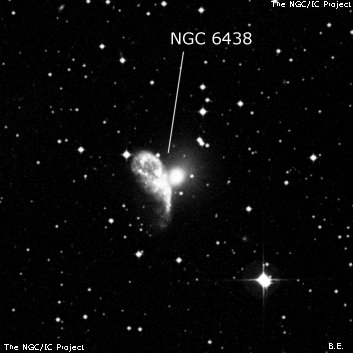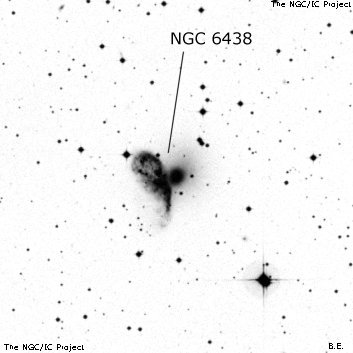NGC/IC Project Restoration Effort
(This is a very very beta version)
NGC6438


Basic Information
Location and Magnitude
Right Ascension: 18:22:15.9
Declination: -85:24:6
Constellation: OCT
Visual Magnitude: 11.7
Historic Information
Discoverer: Herschel J.
Year of discovery: 1835
Discovery aperture: 18.3
Observational
Summary description: pB, R, vgbM
Sub-type: S0
Corwin's Notes
=====
NGC 6438. The canonical way of identifying the objects in this fascinating
interacting pair is to make "NGC 6438" the northwestern lenticular, while the
southeastern distorted spiral is called "NGC 6438A". Given JH's description
"pB, R, vgbM", I can see how this view has come about.
But the spiral is certainly bright and large enough to have figured in the
visibility of JH's object. I'm going to suggest that it, too, is a part of
the NGC object, and I have treated it that way in the position table. You,
of course, may use whichever identification suits your work.
JH's position, by the way, is no help to us. Being as far south as it is, the
RA was difficult to determine. JH writes, "RA rudely taken, and may be very
erroneous." Curiously, he did not mark it uncertain, and it is listed in his
catalogues (and in the NGC) with no uncertainty or notes. In spite of all
this, his RA is only out by about 4 arcminutes.
Steve's Notes
=====
NGC 6438
24" (4/11/08 - Magellan Observatory, Australia): at 260x, the appearance of this interacting pair was very strange! NGC 6438 appeared moderately bright, small, round, 0.4' diameter. NGC 6438A (a disrupted peculiar galaxy), is attached on the east side and appeared as a faint, diffuse glow, elongated SW-NE, ~0.8'x0.5'. This system is the second closest NGC galaxy to the south celestial pole. Located 4' NE of a mag 9.5 star (an uncatalogued double star) and 16' NE of mag 8 HD 160820.
NGC 6438A appears highly disrupted on the DSS, with two extensions or arms (this may be two different interacting galaxies).



